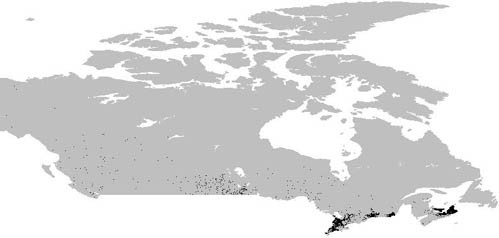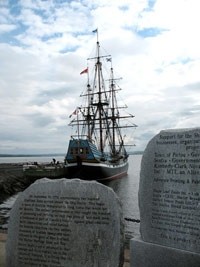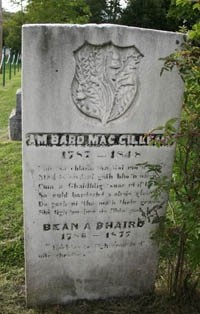Gaelic in Canada
"Na cnuic 's na glinn bu bhòidhche leinn"
Gaelic Settlements in North America
Into the middle of the 1800s Gaelic-speaking communities generally emigrated and settled together. The earliest of these migrations to North America began in the 1730s, when groups went to Georgia, New York state, and the Carolinas. Highland soldiers who had fought in the Seven Years' War (1756-1763) were awarded with land grants in Quebec and New York state, creating magnets for chain migration. As conditions in the Highlands grew increasingly oppressive in the 1770s, emigration, especially to the Carolinas, accelerated. After the American Revolutionary War, however, most migration was redirected to Canada.
It was estimated by churchmen in the late nineteenth century that 250,000 people in Canada spoke Gaelic. They could be found in many different regions, including Nova Scotia, Prince Edward Island, the Codroy Valley of Newfoundland, New Brunswick, the Eastern Townships of Quebec, Glengarry County in Ontario, Bruce County in Ontario, Vancouver, and Winnipeg.

Gaelic on map of Canada from 1901 census
(Jonathan Dembling, 2006)
Gaelic scholar Jonathan Dembling has stated that in this period "Gaelic was truly a Canadian language", adding that it was the "largest non-official language at the time of Confederation (1867)", that is, only behind English and French in the number of speakers.
See Jonathan Dembling, "Gaelic in Canada: new evidence from an old census", Cànan & Cultar / Language & Culture: Rannsachadh na Gàidhlig 3, Dunedin Academic Press, 2006.
The surviving Gaelic poetry of emigrants and their descendants have left vivid impressions and comments about their experiences, challenges, and accomplishments. A selection of these was edited by Sister Margaret MacDonell, former chair of the Department of Celtic Studies, in The Emigrant Experience (University of Toronto Press, 1982).
As in Scotland, however, Gaelic was subjected to neglect and hostility in Canada. It has survived to the present as a community language only in Nova Scotia.
Gaelic in Nova Scotia

The ship Hector arrived in Pictou in 1773, carrying some 189 people who established a Highland community in Pictou County. Many of the first books published in Gaelic in Canada produced in Pictou, such as the Gaelic hymnal Laoidhean Spioradail in 1832 and Companach an Òganaich in 1836. Amongst those settled in eastern mainland Nova Scotia and Cape Breton were accomplished Gaelic scholars, poets, clergymen, and musicians. A few of these have received renewed attention.
The most celebrated of Gaelic poets to have emigrated to North America was Iain MacIlleathain (aka 'John MacLean', am Bàrd MacIlleathain). Born in Tiree in 1787, he was poet to the Lord of Coll until he came to Barney's River (Pictou Country) in 1819, bringing important manuscripts of Gaelic poetry with him. In 1829 he and his family moved to Antigonish County; their settlement is now called Gleann a' Bhaird (Glen Bard) in his memory. He composed an enormous amount of verse in both Scotland and Nova Scotia, and a volume of his work is currently being edited by Dr. Rob Dunbar.

Iain MacGilleBhràth ('Am Pìobaire Mór') was born in Moidart, Scotland, c. 1792 and was a professional piper and poet to MacDonald of Glenaladale. He emigrated in 1818, initially to Prince Edward Island but later to Antigonish. Although he was said to have composed many poems, only a few have been found and identified.
Alasdair Ailein MacDhòmhnaill was born in Glenuig, Scotland, in 1820 and emigrated with his family to Keppoch, Antigonish County, in 1830. What remains of his output has been edited by StFX Librarian Laurinda Matheson and her husband Trueman in the volume O Cheapaich nan Craobh (Sìol, 2008).
Ailean 'the Ridge' MacDhòmhnaill was born in Brae Lochaber, Scotland, in 1794 to a branch of the MacDonalds of Keppoch with a strong poetic tradition. He emigrated to Cape Breton with his family in 1816 and relocated again to Upper South River in Antigonish County in 1847. His poetry has been edited by department associate Effie Rankin in the volume Às a' Bhràighe (CBU Press, 2004).
An t-Urr. Dunnchadh Blàrach (the Rev. Duncan Black Blair) was born in Strachur on the Cowal peninsula in Scotland, in 1815. He journeyed to Nova Scotia in 1846, travelling around the region and preaching at various locations in Cape Breton, Prince Edward Island, Quebec, and Ontario before finally settling in the Barney’s River and Blue Mountain area of Pictou County, Nova Scotia by 1851. Blair published widely in Gaelic periodicals of his day such as An Gàidheal, the Gaelic column of the Rev. Alexander MacLean Sinclair “Cùil na Gàidhlig” in the Pictou News, as well as Mac-Talla. Blair was no mean poet and is especially known today for his poem “Eas Niagara” (“Niagara Falls”), which he composed on his visit to the Falls while in Ontario in 1847. Much of Blair’s work, including poetry, has been published in the book Fògradh, Fàisneachd, Filidheachd / Parting, Prophecy, Poetry, translated and edited by Seonaidh Ailig Mac a’ Phearsain and Michael Linkletter (CBU Press, 2013).
Most emigration to Cape Breton occurred between 1802 and 1843; Jonathan MacKinnon (editor of the all-Gaelic newspaper Mac-Talla) estimated that 25,000 Gaelic emigrants settled in Cape Breton and over 50,000 Gaelic speakers are believed to have lived on the island in the middle of the century. A survey of the poetic remains of Cape Breton identified 170 Gaelic poets from printed sources alone, and many more are known to have existed. This is a testimony to the resilience of Gaelic in immigrant communities and the importance of Gaelic oral tradition to them.
Some Milestones of Scottish Gaelic Publishing in America
- 1791 - Publication of Sermons at Raft-swamp in North Carolina, first Gaelic text printed in North America
- 1832 - Publication of Laoidhean Spioradail in Pictou, Nova Scotia and Ainmeanna Cliuteach Chriosd in Charlottetown, Prince Edward Island
- 1836 - Companach an Òganaich (The Youth's Companion) is written by Alexander MacGillivray and printed in Pictou
- 1836 - Gaelic poetry printed in newspaper the Prince Edward Island Times
- 1840 - Newspaper Cuairtear na Coille printed in Kingston, Ontario
- 1847 - John Boyd prints Spelling Book of Gaelic in Antigonish
- 1851 - Monthly magazine An Cuairtear Òg Gaelach printed by John Boyd in Antigonish for about a year
- 1852 - John Boyd begins the Casket in Antigonish as bilingual weekly newspaper, half-English, half-Gaelic
- 1863 - Norman MacDonald reprints Sàr Obair nam Bard Gaelach in Halifax
- 1871 - Gaelic newspaper An Gàidheal begins in Toronto
- 1880 - Alexander Maclean Sinclair (based in Nova Scotia and later PEI) prints the first of his 15 anthologies of Gaelic poetry
- 1883 - Maclean Sinclair's Gaelic column "Cùil na Gàidhlig" begins in the Pictou News
- 1885 - Calum McLeod prints Òrain Iain Mhorastain in Baddeck, Cape Breton
- 1892-1904 - the all-Gaelic newspaper Mac-Talla published in Sydney, Cape Breton
Contact
207 Immaculata Hall
2360 Notre Dame Avenue
Antigonish NS B2G 2W5
Canada

